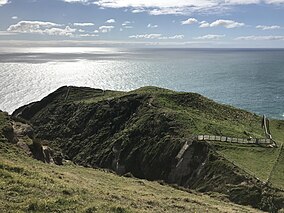| Wharariki Ecosanctuary | |
|---|---|
 | |
| Nearest city | Collingwood |
| Coordinates | 40°29′57″S 172°41′44″E / 40.4992°S 172.6956°E / -40.4992; 172.6956 |
| Area | 2.5 ha (6.2 acres) |
| Established | January 2020 |
| Operator | Farewell Wharariki HealthPost Nature Trust |
Wharariki Ecosanctuary is a wildlife sanctuary within a predator-proof fence at Cape Farewell, New Zealand.
Location
The Wharariki Ecosanctuary is located on a headland on the Wharariki coastline at Cape Farewell. It is sited on conservation land that is managed as the Puponga Farm Park.
Establishment
The project was initiated by Peter Butler, who created a trust in 2017 to protect local wildlife in the region from Wharariki Beach to the tip of Farewell Spit. The Farewell Wharariki HealthPost Nature Trust was registered as a Charitable Trust in May 2021.
The sanctuary has been created in a collaboration between the Collingwood-based HealthPost Nature Trust, the Department of Conservation and Manawhenua ki Mōhua, representing Ngāti Tama, Te Ātiawa and Ngāti Rārua in the Golden Bay/ Mohua area. Starting in September 2019, a 200 metres (660 ft) predator-proof fence was constructed above the cliffs at Wharariki, enclosing 2.5 ha (6.2 acres). The fence was completed in January 2020, and the sanctuary was officially opened by Eugenie Sage (Minister of Conservation), along with local iwi, and the sanctuary patron, broadcaster Kim Hill.
Prior to the translocation of burrow-nesting seabirds, the area was prepared by building artificial burrows, trapping pests and planting around the site.
In the Sustainable Business Awards 2021, HealthPost received a commendation in the Restoring Nature Award category, for their work in developing the ecosanctuary.
-
 Cape Farewell prior to the establishment of the ecosanctuary
Cape Farewell prior to the establishment of the ecosanctuary
-
 After the ecosanctuary's predator-proof fence was built
After the ecosanctuary's predator-proof fence was built
Revegetation
By 2021, around 3000 trees had been planted in the sanctuary and around the Wharariki wetland. Species planted include kanuka, kaikomako and ti kouka (cabbage tree).
Translocation of fluttering shearwaters

In January 2022, 50 fluttering shearwater (Puffinus gavia) or pakahā chicks were translocated from the Long Island – Kokomohua Marine Reserve in Queen Charlotte Sound to the Wharariki Ecosanctuary. They were the first species to be introduced to the fenced sanctuary.
In January 2023, another 56 fluttering shearwater chicks were translocated from the Long Island – Kokomohua Marine Reserve to the Wharariki Ecosanctuary. They were transferred due to weather events impacting their burrows on Long Island. It is hoped they will establish a breeding colony. One of the group of volunteers assisting with the relocation was teenage environmentalist Nate Wilbourne.
A third translocation of chicks to the sanctuary was undertaken in January 2024, with 92 chicks moved from Long Island – Kokomohua.
References
- "Farewell Wharariki Eco Sanctuary". Lone Star Farms. Archived from the original on 23 May 2022. Retrieved 18 April 2022.
- "Farewell Spit and Puponga Farm Park". Department of Conservation. Archived from the original on 29 May 2022. Retrieved 18 April 2022.
- "Peter Butler: Building a predator-free sanctuary". RNZ. 14 December 2019. Archived from the original on 23 January 2022. Retrieved 18 April 2022.
- "Farewell Wharariki HealthPost Nature Trust". NZBN. Archived from the original on 17 April 2022. Retrieved 18 April 2022.
- Gee, Samantha (20 September 2019). "New sanctuary to boost seabird numbers at Cape Farewell". Stuff. Archived from the original on 5 April 2023. Retrieved 23 June 2023.
- "Predator-free sanctuary for seabirds, rare native plants opens at Cape Farewell". RNZ. 18 January 2020. Archived from the original on 29 January 2022. Retrieved 18 April 2022.
- O'Connell, Tim (19 January 2020). "Conservation minister opens new Golden Bay ecosanctuary at Cape Farewell". Stuff. Archived from the original on 5 April 2023. Retrieved 23 June 2023.
- ^ Sivignon, Cherie (20 January 2022). "First fluttering shearwater chicks arrive at Cape Farewell sanctuary". Stuff. Archived from the original on 26 January 2022. Retrieved 26 January 2022.
- "2021 Restoring Nature Award". Sustainable Business Network. Archived from the original on 28 May 2022. Retrieved 21 April 2022.
- "Cape Farewell ecosanctuary progressing despite setbacks". New Zealand Geographic. Retrieved 23 June 2023.
- Hindmarsh, Gerard (27 November 2021). "Once hunted but 'Flocks of gods' now venerated at Farewell Spit". Nelson Mail. Archived from the original on 21 April 2022. Retrieved 21 April 2022 – via Stuff.
- Gee, Samantha (23 January 2022). "Hope seabirds establish new colony at Cape Farewell Sanctuary". RNZ. Archived from the original on 17 February 2022. Retrieved 18 April 2022.
- Hart, Maia (24 January 2023). "Second round of fluttering shearwater introduced to Cape Farewell from Marlborough Sounds". RNZ. Archived from the original on 25 January 2023. Retrieved 25 January 2023.
- "Volunteers to release 100 pakahā chicks at Cape Farewell ecosanctuary". RNZ. 21 January 2023. Archived from the original on 9 June 2023. Retrieved 23 June 2023.
- Jones, Katy (12 January 2024). "Third round of seabird chicks headed for Cape Farewell in restoration effort". The Press. Retrieved 14 January 2024.
- Jones, Katy (21 January 2024). "Bigger haul of seabirds in effort for first re-established colony on South Island's mainland". Stuff. Retrieved 21 January 2024.
External links
| Tasman District, New Zealand | |||||||||||
|---|---|---|---|---|---|---|---|---|---|---|---|
| Seat: Richmond | |||||||||||
| Populated places |
| ||||||||||
| Geographic features |
| ||||||||||
| Facilities and attractions |
| ||||||||||
| Government | |||||||||||
| Organisations | |||||||||||
| Schools | |||||||||||